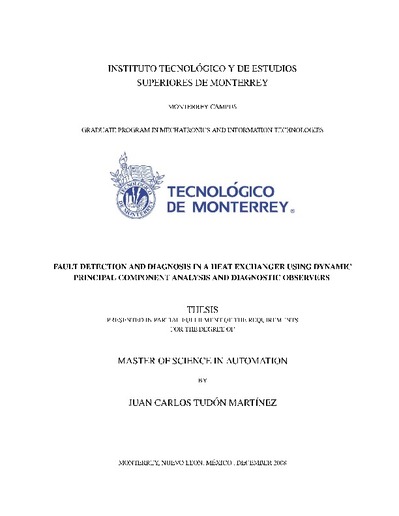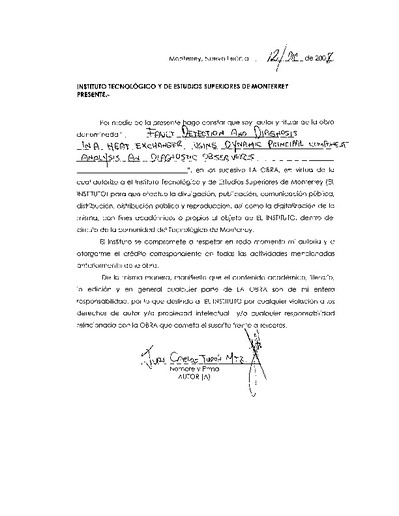| dc.contributor.advisor | Morales Menéndez, Ruben | |
| dc.contributor.author | Tudón Martínez, Juan Carlos | |
| dc.creator | TUDON MARTINEZ, JUAN CARLOS; 229809 | |
| dc.date.accessioned | 2015-08-17T10:13:39Z | en |
| dc.date.available | 2015-08-17T10:13:39Z | en |
| dc.date.issued | 2008-12-01 | |
| dc.identifier.uri | http://hdl.handle.net/11285/569071 | en |
| dc.description.abstract | Quick detection and correct isolation of soft faults in a control system allow to improve the product quality, particularly in chemical processes, for example: an industrial heat exchanger. According to Venkatasubramanian, the fault methods can be classified as: model-based methods and historical data-based methods. In this thesis, two Fault Detection and Isolation (FDI) systems are designed and validated in the same process, i.e. in a shell and tube industrial heat exchanger. One of them is based on the Dynamic Principal Component Analysis (DPCA) method and the another one on a set of diagnostic observers. The former method requires historical data of the process, whereas, the diagnostic observers use quantitative models. Before testing both methods, they are trained in the same normal operating point. Four kinds of faults are introduced under the same process conditions in order to compare the performance of both diagnostic methods. All these fault cases are considered as soft faults in sensors or actuators; the faults are implemented with abrupt or gradual behavior. Similar metrics are defined in both FDI methods in order to analyze the desirable characteristics of any fault diagnostic system: robustness, quick detection, isolability capacity, explanation facility, false alarm rates and multiple faults identifiability. Experimental results show the principal advantages and disadvantages of both methods and allows to present a comparative table with the achieved performance of each method.
This work allows to design and development both methods in parallel. The Recursive Least Squares (RLS) method is used to identify the process through a Random Binary Signal (RBS) test. The reliable model of each fault allows to design a set of diagnostic observers. On the other hand, a statistical analysis based on historical data is designed to know the operating status. The DPCA method projects the data into two new spaces in order to detect any abnormal event using a smaller number of process variables. In this manner, two methods, based on different approaches, are tested under the same experimental data. This work shows that a set of diagnostic observers can detect a soft fault in a sensor or actuator at shorter time than the DPCA method. The diagnostic observers present a lower false alarm rate than the DPCA method, when soft faults in actuators are implemented. Furthermore, diagnostic observers can identify multiple faults, whereas the DPCA method can not associate correctly the errors to the occurred faults. However, the training and testing stages of the diagnostic observers require greater computational resources than the stages of the DPCA method. | en |
| dc.format.medium | Texto | |
| dc.language | eng | |
| dc.publisher | Instituto Tecnológico y de Estudios Superiores de Monterrey | |
| dc.relation | Investigadores | es_MX |
| dc.relation | Estudiantes | es_MX |
| dc.relation.isFormatOf | versión publicada | es_MX |
| dc.relation.isreferencedby | REPOSITORIO NACIONAL CONACYT | |
| dc.rights | openAccess | |
| dc.rights.uri | http://creativecommons.org/licenses/by-nc-nd/4.0 | * |
| dc.subject.classification | INGENIERÍA Y TECNOLOGÍA::CIENCIAS TECNOLÓGICAS::TECNOLOGÍA DE LA INSTRUMENTACIÓN::TECNOLOGÍA DE LA AUTOMATIZACIÓN | es_MX |
| dc.title | Fault detection and diagnosis in a heat exchanger using dynamic principal component analysis and diagnostic observers | |
| dc.type | Tesis de Maestría / master Thesis | |
| dc.contributor.department | Graduate Program in Mechatronics and Information Technologies | en |
| dc.contributor.chair | Acevedo Mascarúa, Joaquín | |
| dc.contributor.committeemember | Guedea Elizalde, Federico | |
| dc.contributor.committeemember | Ramírez Mendoza, Ricardo A. | |
| dc.contributor.division | Division of Mechatronics and Information Technologies | en |
| dc.subject.keyword | Fault detection and diagnosis | en |
| dc.subject.keyword | Heat exchanger | en |
| dc.subject.keyword | Dynamic principal component analysis | en |
| dc.subject.keyword | Diagnostic observers | en |
| dc.contributor.institution | Monterrey Campus | en |
| dc.description.degree | Master of Science in Automation | en |
| refterms.dateFOA | 2018-03-18T19:06:47Z | |
| dc.identificator | 7||33||3311||331101 | |


